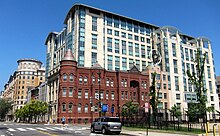Our website is made possible by displaying online advertisements to our visitors.
Please consider supporting us by disabling your ad blocker.
National Academies of Sciences, Engineering, and Medicine
 The Keck Center of the National Academies in Washington, D.C. | |
Location of NASEM in Washington, D.C. | |
| Abbreviation | NASEM |
|---|---|
| Predecessor | Council of National Defense – Department of Science and Research United States Army Signal Corps – Science and Research Division |
| Formation | 1863 (as National Academy of Sciences) 1916 (as National Research Council) 2015 (as National Academies of Sciences, Engineering, and Medicine)[1][2] |
| Founder | Federal Government of the United States |
| Type | National Academy |
| 53-0196932 | |
| Legal status | Congressionally Chartered Nonprofit Organization |
| Purpose | Provide independent, objective advice to inform policy with evidence, spark progress and innovation, and confront challenging issues for the benefit of society.[3] |
| Headquarters | Keck Center 500 5th Street, NW, Washington, D.C. 20001 |
| Location |
|
| Coordinates | 38°53′48″N 77°01′10″W / 38.89667°N 77.01944°W |
| Membership | Scientists, engineers, and health professionals |
Official language | English |
| Marcia McNutt[4] | |
President (NAE) | John L. Anderson[4] |
President (NAM) | Victor Dzau[4] |
| Subsidiaries | National Academy of Sciences (NAS) National Academy of Engineering (NAE) National Academy of Medicine (NAM) |
| Website | www |
The National Academies of Sciences, Engineering, and Medicine (NASEM), also known as the National Academies, is a congressionally chartered organization that serves as the collective scientific national academy of the United States. The name is used interchangeably in two senses: (1) as an umbrella term or parent organization for its three sub-divisions that operate as quasi-independent honorific learned society member organizations known as the National Academy of Sciences (NAS), the National Academy of Engineering (NAE), and the National Academy of Medicine (NAM); and (2) as the brand for studies and reports issued by the unified operating arm of the three academies originally known as the National Research Council (NRC). The National Academies also serve as public policy advisors, research institutes, think tanks, and public administration consultants on issues of public importance or on request by the government.[5][6][7][8][9]
The National Research Council, National Academy of Engineering, and National Academy of Medicine began as activities of the National Academy of Sciences until they were reorganized in 2015 into units of the current National Academies while maintaining the charter status and corporate successorship of the original National Academy of Sciences.
Now jointly governed by all three academies, the NRC produces some 200 publications annually which are published by the National Academies Press. The reports produced by the National Academies have been characterized as reflective of scientific consensus.[10]
- ^ "Overview: NAS History". National Academy of Sciences. Retrieved June 10, 2020.
- ^ Blair, Peter D. (2016). "The evolving role of the US National Academies of Sciences, Engineering, and Medicine in providing science and technology policy advice to the US government". Palgrave Communications. 2. Springer Nature. doi:10.1057/palcomms.2016.30.
- ^ "About us". National Academies of Sciences, Engineering, and Medicine. Retrieved June 10, 2020.
- ^ a b c "Our Leadership". National Academies of Sciences, Engineering, and Medicine. Retrieved June 10, 2020.
- ^ "Policy and Global Affairs Units". www.nationalacademies.org. Retrieved June 5, 2020.
- ^ "Cooperative Research Programs Division". Transportation Research Board. Archived from the original on June 7, 2020. Retrieved June 5, 2020.
- ^ https://www.nationalacademies.org/about [About Us]
- ^ https://www.nationalacademies.org/ocga [Congressional and Government Affairs]
- ^ Blair, Peter D. (June 7, 2016). "The evolving role of the US National Academies of Sciences, Engineering, and Medicine in providing science and technology policy advice to the US government". Palgrave Communications. 2 (1): 1–7. doi:10.1057/palcomms.2016.30. ISSN 2055-1045.
- ^ Hicks, Diana; Zullo, Matteo; Doshi, Ameet; Asensio, Omar I. (March 1, 2022). "Widespread use of National Academies consensus reports by the American public". Proceedings of the National Academy of Sciences. 119 (9). Bibcode:2022PNAS..11907760H. doi:10.1073/pnas.2107760119. ISSN 0027-8424. PMC 8892306. PMID 35193972.
Previous Page Next Page
الاكاديميات الوطنيه للعلوم ، الهندسه و الطب ARZ National Academies of Sciences, Engineering, and Medicine German Académies nationales des sciences, d'ingénierie et de médecine French Akademi Sains, Teknik, dan Kedokteran Nasional ID 全米アカデミーズ Japanese 전미과학공학의학한림원 Korean Улуттук илимдер, инженерия жана медицина академиясы KY United States National Academies Polish Academias Nacionais de Ciências, Engenharia e Medicina Portuguese Национальные академии наук, инженерии и медицины Russian



